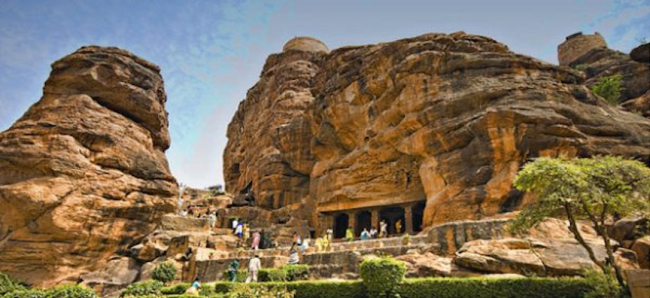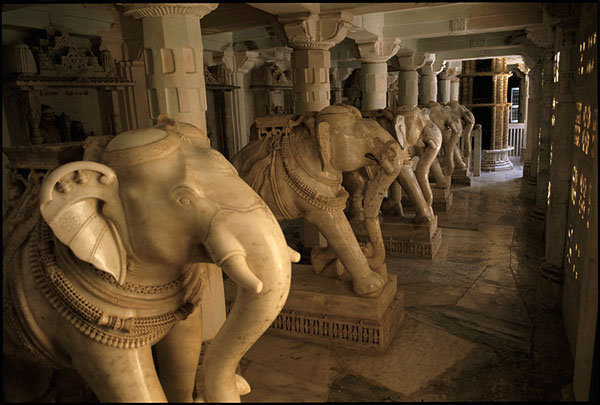TIMELINE OF TEMPLES IN INDIA FROM 3000 BCE-TODAY WITH RECONSTRUCTION
Click for Source Article in IndiaTimes

CAVE TEMPLE IN INDIA Badami Cave Temples, Karnataka
3,000 BCE: Temples in India — At an estimated 5000 years old the Tugnath Temple, in Uttarakhand India was built 12,073 feet in the Himalayan Mountains, highest temple in the world considered the land of the gods, as part of a chain of temples called Panch Kedar, including Madhyamaheshwar, Kedarnath, Rudranath and Kalpeshwar. The temple is connected to the Ramayana where Lord Ram meditated to release the curse of Brahmahatya for having slaughtered Ravana. The temple is quite small, and hence only 10 people are allowed in at a time.
3,500 BCE-2,300 BCE: Temples in India — Terracotta Shiva Linga figurines at Indus Valley Civilization site of Kalibangan and other sites provide evidence of early Shiva Linga worship.
269 BCE-232 BCE: India — Emperor Ashoka’s Rock Edicts in Nittur and Udegolan in Bellary district suggest this region was part of the Maurya Empire during the 3rd century BCE. A Brahmi inscription and a terracotta seal dating to about the 2nd century CE have been found during site excavations.

INTERIOR OF TEMPLE IN INDIA – Dilwara Temples
250 BCE-1215 AD: Temples in India — The group temples in the Girnar mountains in the Junagadh District of Gujarat, India were initiated and built over a millennium. The temples on the hill sacred to the Digambara and the Svetambara branches of Jainism. Girnar mountain is highest mountain of Gujarat state, India. On the mountain there are many temples of Hindu and Jain religion. Girnar was anciently called Raivata or Ujjayanta, sacred amongst the Jains to Neminath, the 22nd Tirthankar, and a place of pilgrimage before the days of Ashoka, 250 BCE. These temples of Jainism were carvings in marble. Sixteen Jain temples form a sort of fort on the ledge at the top of the great cliff. In the North porch are inscriptions which state that in Samwat 1215 AD certain Thakurs completed the shrine, and built the Temple of Ambika.
578 AD: Temples in India — Badami Cave Temples, Karnataka are a complex of temples located in the northern part of Karnataka, India. They are considered an example of Indian rock-cut Badami Chalukya Architecture. Four Hindu Jain and possibly Buddhist cave temples are dated from the late 6th century onwards. The exact dating is known only for Cave 3, which is a temple dedicated to Vishnu and has an inscription dated 578 AD-579 AD. This makes the cave the oldest firmly-dated Hindu cave temple in India. Badami is situated on the west bank of a man-made lake ringed by an earthen wall with stone steps and is surrounded on the north and south by forts built in later times.
600s AD-1600s AD: Temples in India — Adi Kumbeswarar, Tamil Nadu in the temple town Kumbhakonam, India dates back to the Vijaynagara period. Adi Kumbeswarar is the presiding deity of the temple and the shrine is located in the centre. Kumbeswarar is in the form a lingam believed to have been made by Shiva himself when he mixed the nectar of immortality and sand. The temple began in Chola times in 600s AD and has been widely expanded by Nayaks during the 15-17th century.
756 AD-813 AD: Temples in India — Kailashnath Temple, Ellora built as a dedication greatness of Lord Shiva, the destroyer was carved in perfect proportion and alignment to its adjacent structures, which include columns, flying bridges, stone arches, and statues and buildings – all made out of a single piece of rock. Its construction is generally attributed to the Rashtrakuta king Krishna I (756 AD-773 AD). The Baroda copper-plate inscription (812 AD-813 AD) of ruler Karkaraja II and also mentions a Shiva temple at Elapura (Ellora). It states that the king constructed a temple so wonderous that even the gods and the architect were astonished, likely referring to the Kailasa Shiva temple at Elora.
950 AD-1250 AD: Temples in India — Important Hindu temples were built in this time period. Rajarani Temple + Anant Vasudev Temple + Jagannath Temple, Puri + Khajuraho Temples + Totesvara Mahadeo Temple in Kadawa built in central & eastern India likely by Chandela dynasty & Somavamsi kings who migrated from Central India to Orissa during the same period. Unlike the stone and metal icons found in most Hindu temples, the image of Jagannath is made of wood and is ceremoniously replaced every twelve or nineteen years by an exact replica. Khajuraho temple site had 85 temples by the 12th century. Brihadeshwara Temple, Tanjore, Tamil Nadu was built by King Rajaraja Chola in 1002 AD and is the finest example of Dravidian art composed of many interconnected structures including pavilion, pillared portico and a large hall.
1000s AD-1200s AD: Temples in India — Five Dilwara Temples near Mount Abu, Rajasthan, were built with remarkable stunning marble. These five temples (Vimal Vasahi, Luna Vasahi, Pittalhar Temple, Parshvanatha Temple and Mahavir Swami Temple) are considered the most beautiful Jain pilgrimage sites in the world.
1053 AD: Temples in India — Varadharaja Perumal Temple, Tamil Nadu is a Hindu temple dedicated to Lord Vishnu located in the holy city of Kanchipuram. It is one of the Divya Desams, the 108 temples of Vishnu believed to have been visited by the 12 poet saints, or Alwars. It is believed that the lizard sculptures that adorn the ceilings of the temple when touched forgive the sins of your past life. The temple was first built by the by the Cholas & Pallava king Nandivarman II. There are inscriptions dated 1532 AD.
1117 AD: Temples in India — Chennakeshava Hindu Temple, Karnataka on the banks of the Yagachi river, was an early masterpiece of the Hoysala Period. It was built by the Vijayanagara ruler to commemorate his victories and dedicated to Gods – Vishnu & the God seated with Lakshmi. The Chennakeshava Temple or Vijayanarayana Temple of Belur commissioned by King Vishnuvardhana, an early Hoysala Empire capital. The temple took 103 years to finish.
1250 AD: Temples in India — Konark Sun Temple, Odisha, India was built by King Narasimhadeva I of the Eastern Ganga Dynasty is in the shape of a gigantic chariot with elaborately carved stone wheels, pillars and walls. This temple was called the “Black Pagoda” in European sailor accounts as early as 1676 AD because its great tower appeared black. The Jagannath Temple in Puri was called the “White Pagoda”. Both temples served as important landmarks for sailors in the Bay of Bengal.
1300s AD: Temples in India — Jagatpita Brahma Mandir is a Hindu temple situated at Pushkar in the Indian state of Rajasthan & is said by some to be a 2000 years old temple, but most say the 1300s AD. The temple is mainly built of marble and stone slabs. It has a distinct red pinnacle and a bird motif. The temple sanctum sanctorum holds the central images of Brahma and his second consort Gayatri. Pushkar has 80 large temples and 400 smaller temples but many were destroyed during the Mughal emperor Aurangzeb’s invasion and rule (1658 AD–1707 AD) but were re-built subsequently. It is believed that Brahma himself chose the location for his temple and Pushkar is often described in the scriptures as the only Brahma temple in the world, owing to the curse of Savitri, “King of the sacred places of the Hindus”. International Business Times has identified Pushkar Lake and the Brahma temple as one of the ten most religious places in the world and one of the five sacred pilgrimage places for the Hindus, in India.
1300s AD-1500s AD: Temples in India — Hampi has a Group of Monuments, a UNESCO World Heritage Site, located in east-central Karnataka, India. It became the centre of the Hindu Vijayanagara Empire capital in the 14th century. Chronicles left by Persian and European travellers, particularly the Portuguese, state Hampi was a prosperous, wealthy and grand city near the Tungabhadra River, with numerous temples, farms and trading markets. By 1500 AD, Hampi-Vijayanagara was the world’s second-largest medieval-era city after Beijing, and probably India’s richest at that time, attracting traders from Persia and Portugal. The Vijayanagara Empire was defeated by a coalition of Muslim sultanates; its capital was conquered, pillaged and destroyed by sultanate armies in 1565, after which Hampi remained in ruins. Vittala Temple, Hampi, Karnataka, is one of the most popular of all the temples in the Hampi complex, this houses the famous musical pillars that have amazing acoustics. The British wanted to find out the reason behind this, and so they cut two pillars to check if there was anything inside that was producing the sound. They found nothing but hollow pillars. The road leading to the temple was once a market where horses were traded. Even today we can see the ruins of the market on both the sides of the road. The temple contains images of foreigners like Persians selling horses.
1501 AD-1627 AD: Temples in India — A fort was built following the founding of the Orchha State by ruler Rudra Pratap Singh (1501 AD–1531 AD). The palaces and temples within the fort complex were built over a period of time by successive Maharajas of the Orchha State. Of these, the Raja Mandir or Raja Mahal was built by Madhukar Shah who ruled from 1554 to 1591. The fort complex features “pepper pots and domes” and are believed to have inspired Lutyens in the architecture of the structures which he built in New Delhi. The Orchha Temples, Madhya Pradesh in Orchha is famous and is near the famous Khajuraho Temple. The town has Chaturbhuj Temple, Lakshmi Temple and Ram Raja Temple. The Chaturbhuj temple is imposing with tall spires built atop a high platform. Its exterior is richly ornamented with lotus symbols. The Raja Ram Temple resembles a palace as the Ram is worshiped as a king here. The Lakshmi Temple is an odd mixture of temple and fort and a unique mixture of concentric forms. It consists of an octagonal central tower inside a triangular temple. In line with this eccentricity, the entrance gate is set in a corner rather than the wall.
1643 AD: Temples in India — Pancha Ratna Shiva Temple, also known as Bhubaneswar Shiva Mandir, is a Hindu temple of the Puthia Temple Complex in Puthia Upazila, Rajshahi Division, Bangladesh. The shrine overlooks the Shiv Sagar (Shiva’s lake) to its left. The temple is well decorated with five spires. Among the surviving Hindu temples, this shrine is said to be “an exceptional and more attractive for its architectural beauty” in Bangladesh. The walls are richly decorated with terracotta carvings featuring aspects of Lord Krishna’s life.
Source Article from https://concisepolitics.com/2018/02/05/timeline-of-temples-in-india-from-3000-bce-today-with-reconstruction/
Related posts:
Views: 0
 RSS Feed
RSS Feed















 February 5th, 2018
February 5th, 2018  Awake Goy
Awake Goy  Posted in
Posted in  Tags:
Tags: 
















